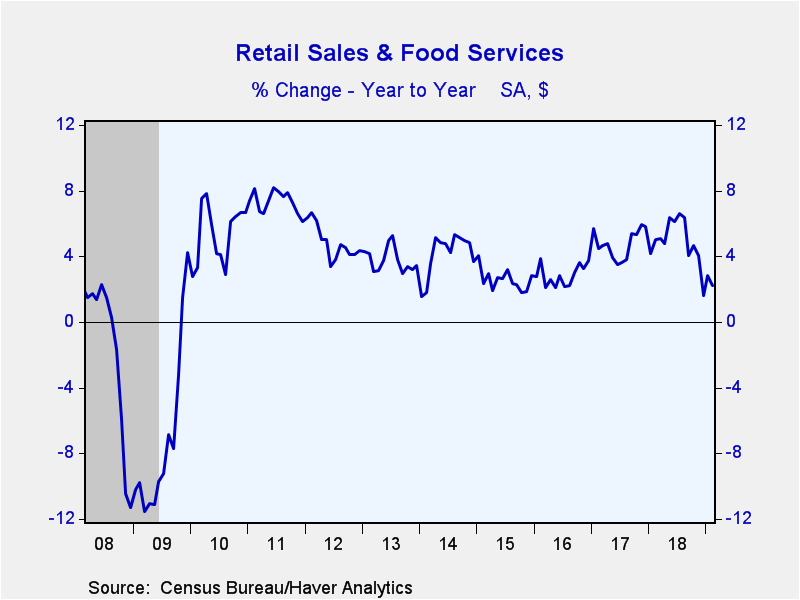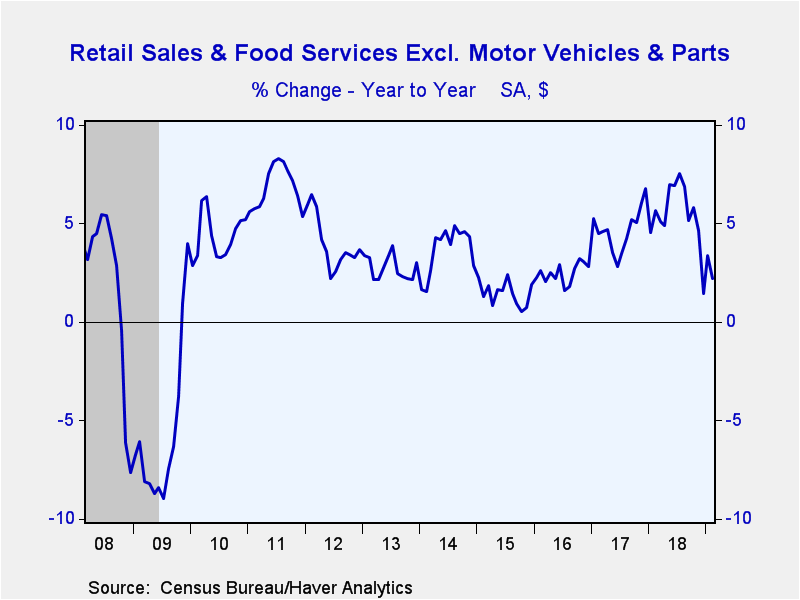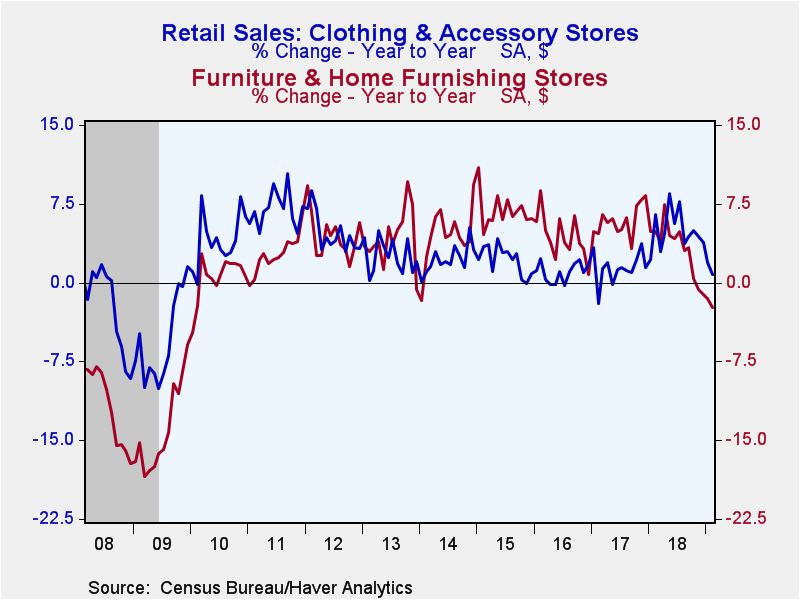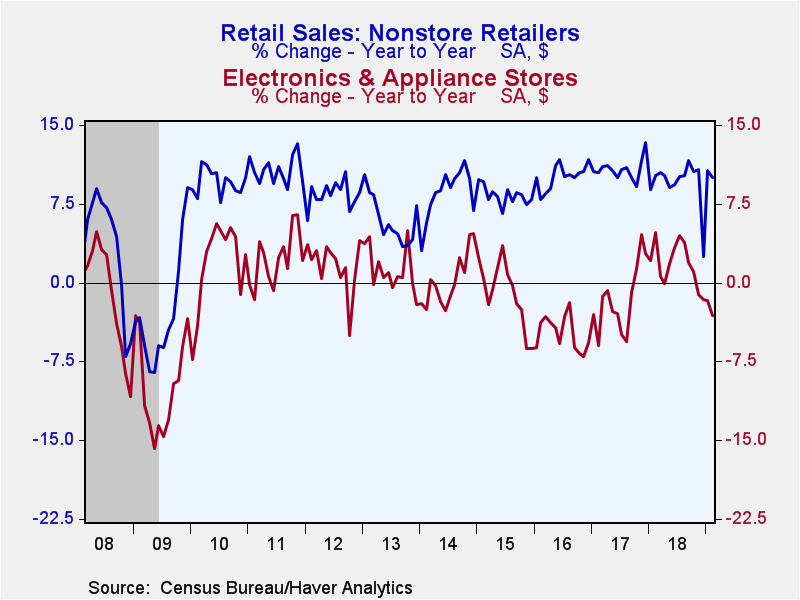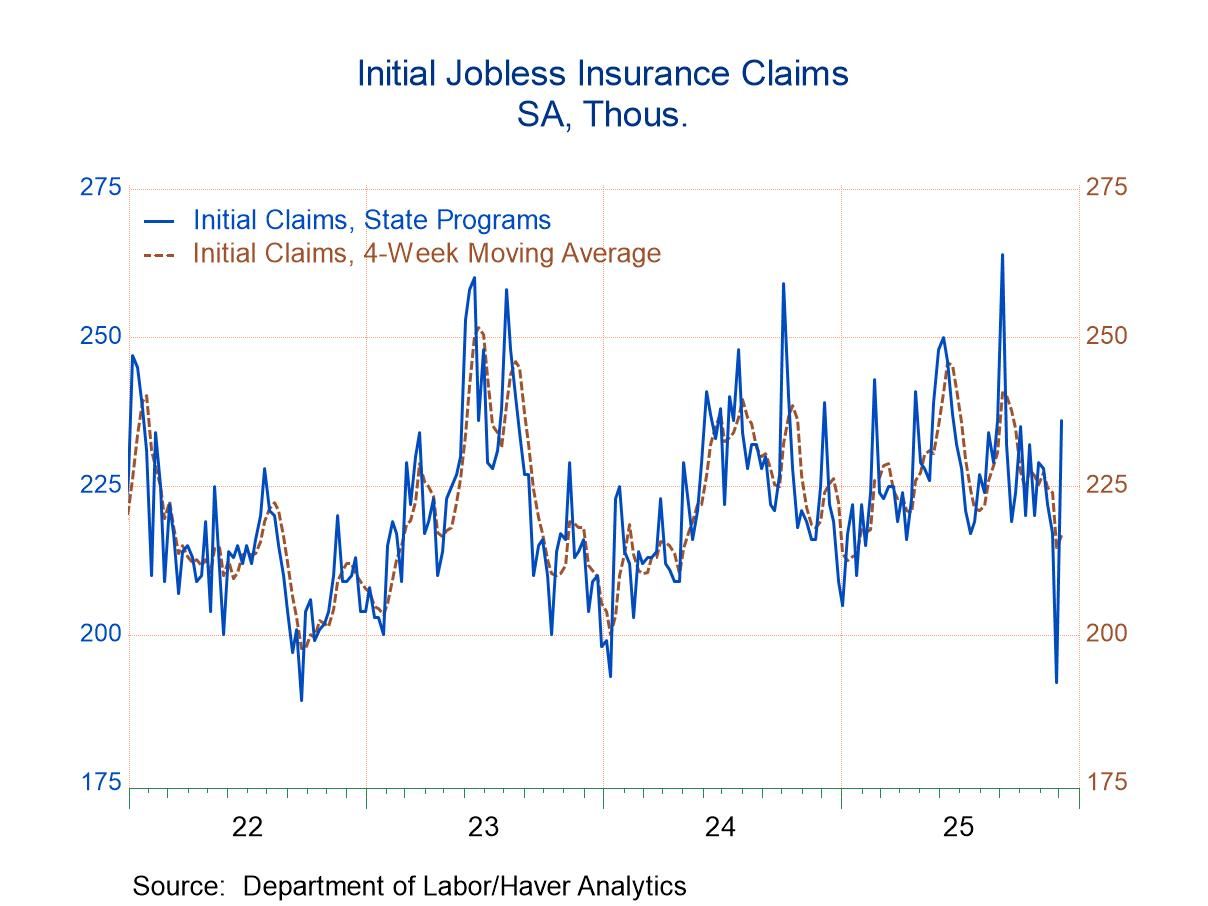 Global| Apr 01 2019
Global| Apr 01 2019U.S. Retail Sales Ease in Broad-Based Decline
by:Tom Moeller
|in:Economy in Brief
Summary
Total retail sales fell 0.2% during February (+2.2% y/y) following a 0.7% January increase, revised from 0.2%. A 0.2% gain had been expected in the Action Economics Forecast Survey. Retail sales excluding motor vehicles and parts [...]
Total retail sales fell 0.2% during February (+2.2% y/y) following a 0.7% January increase, revised from 0.2%. A 0.2% gain had been expected in the Action Economics Forecast Survey. Retail sales excluding motor vehicles and parts declined 0.4% (+2.2% y/y) after a 1.4% increase, revised from 0.9%. A 0.3% rise had been expected.
A measure of the underlying pace of retail spending is nonauto sales growth excluding gasoline and building materials. These sales fell 0.2% in February (+2.9% y/y) following a 1.7% January rise, revised from 1.1%.
A 4.4% decline (+1.4% y/y) in sales of building materials and garden equipment held back overall retail sales in February as it reversed the prior month's increase. Electronic & appliance store sales also were weak and fell 1.3% (-3.1% y/y), down for five months in the last six. Furniture & home furnishings store sales were off 0.9% (-2.7% y/y) and have fallen 4.2% since their peak last April. Apparel store sales fell 0.4% (+0.8% y/y), down for the third straight month. General merchandise store sales fell 0.3% (1.2% y/y), led by a 0.5% decline (-4.0% y/y) in department store sales, the third straight monthly decline.
Offsetting these declines was a 0.9% rise (10.0% y/y) in nonstore retail sales. That followed a 4.5% recovery from a like-sized decline in December. Motor vehicle sales in dollar terms improved 0.7% (2.4% y/y), though unit motor vehicle purchases eased 0.8%. Also rising by 0.5% (-8.8% y/y) were sporting goods, hobby, book & music store sales, but these sales have been declining since mid-2016.
In the nondiscretionary retail spending categories, food & beverage store sales declined 1.2% (+1.9% y/y) following a 1.4% rise. Health & personal care store sales increased 0.6% (5.9% y/y) after a 2.4% gain.
Food service & drinking establishment sales inched 0.1% higher (3.6% y/y), but have fallen slightly over the last six months.
The retail sales data can be found in Haver's USECON database. The Action Economics forecast is in the AS1REPNA database.
| Retail Spending (% chg) | Feb | Jan | Dec | Feb Y/Y | 2018 | 2017 | 2016 |
|---|---|---|---|---|---|---|---|
| Total Retail Sales & Food Services | -0.2 | 0.7 | -1.6 | 2.2 | 4.9 | 4.3 | 3.1 |
| Excluding Autos | -0.4 | 1.4 | -2.1 | 2.2 | 5.4 | 4.3 | 2.7 |
| Retail Sales | -0.2 | 0.8 | -1.8 | 2.1 | 4.8 | 4.5 | 2.8 |
| Retail Less Autos | -0.5 | 1.6 | -2.5 | 2.0 | 5.3 | 4.5 | 2.2 |
| Motor Vehicle & Parts | 0.7 | -1.9 | 0.4 | 2.4 | 2.9 | 4.3 | 4.6 |
| Gasoline Stations | 1.0 | -1.2 | -5.9 | -3.2 | 13.0 | 8.8 | -5.7 |
| Food Service & Drinking Places Sales | 0.1 | 0.0 | -0.2 | 3.6 | 6.0 | 2.7 | 5.6 |
Tom Moeller
AuthorMore in Author Profile »Prior to joining Haver Analytics in 2000, Mr. Moeller worked as the Economist at Chancellor Capital Management from 1985 to 1999. There, he developed comprehensive economic forecasts and interpreted economic data for equity and fixed income portfolio managers. Also at Chancellor, Mr. Moeller worked as an equity analyst and was responsible for researching and rating companies in the economically sensitive automobile and housing industries for investment in Chancellor’s equity portfolio. Prior to joining Chancellor, Mr. Moeller was an Economist at Citibank from 1979 to 1984. He also analyzed pricing behavior in the metals industry for the Council on Wage and Price Stability in Washington, D.C. In 1999, Mr. Moeller received the award for most accurate forecast from the Forecasters' Club of New York. From 1990 to 1992 he was President of the New York Association for Business Economists. Mr. Moeller earned an M.B.A. in Finance from Fordham University, where he graduated in 1987. He holds a Bachelor of Arts in Economics from George Washington University.


